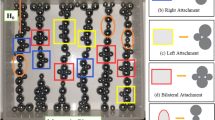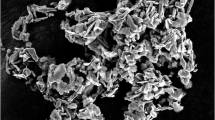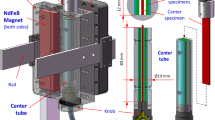Abstract
In order to use shear yield stress model of magnetorheological fluid more accurately, the influence of particle size, particle spacing and magnetic field intensity on the model error of single-chain dipole is compared and analyzed based on the finite element model. The results show that particle size and particle spacing have few effects on the single-chain dipole model, but the magnetic field intensity is the most important factor affecting the error of single-chain dipole model. As the magnetic field strengthens, the error of the single-chain dipole model decreases gradually. Based on the research, the single-chain dipole model is optimized by finite element method. Experimental results show that the error of optimized single-chain dipole model is reduced by 80% compared with that of the model before optimization, which is more accurate.













Similar content being viewed by others
References
Bica, I.; Liu, Y.D.; Choi, H.J.; et al.: Physical characteristics of magnetorheological suspensions and their applications. J. Ind. Eng. Chem. 19(2), 394–406 (2013). https://doi.org/10.1016/j.jiec.2012.10.008
Wang, D.M.; Tian, Z.Z.; Meng, Q.R.; et al.: Development of a novel two-layer multiplate magnetorheological clutch for high-power applications. Smart Mater. Struct. (2013). https://doi.org/10.1088/0964-1726/22/8/085018
Wang, S.Y.; Chen, F.; Tian, Z.Z.; et al.: Development of water-cooling transmission device for magnetorheological fluid. J. Magn. 23(2), 285–292 (2018). https://doi.org/10.4283/JMAG.2018.23.2.285
Kikuchi, T.; Abe, I.; Inoue, A.; et al.: Characteristics of a magnetorheological fluid in high shear rate. Smart Mater. Struct. (2016). https://doi.org/10.1088/0964-1726/25/11/115021
Fujitani, H; Sodeyama, H; Tomura, T.; et al: Development of 400 kN magnetorheological damper for a real base-isolated building. In: Smart Structures and Materials 2003 Conference, March 2003, pp. 265–276 (2003). https://doi.org/10.1117/12.483810
Rizzo, R.; Musolino, A.; Lai, H.C.: An electrodynamic/magnetorheological clutch powered by permanent magnets. IEEE Trans. Magn. (2017). https://doi.org/10.1109/tmag.2016.2628822
Shamieh, H.; Sedaghati, R.: Development, optimization, and control of a novel magnetorheological brake with no zero-field viscous torque for automotive applications. J. Intell. Mater. Syst. Struct. 29(16), 3199–3213 (2018). https://doi.org/10.1177/1045389X18758186
Damiani, R.; Sun, L.Z.: Microstructural characterization and effective viscoelastic behavior of magnetorheological elastomers with varying acetone contents. Int. J. Damage Mech. 26(1), 103–117 (2017). https://doi.org/10.1177/1056789516657676
Chen, F.; Tian, Z.Z.; Wu, X.F.: Research on preparation and characteristics of a novel transmission magnetorheological fluid. J. Magn. 23(1), 1–7 (2018). https://doi.org/10.4283/JMAG.2018.23.1.099
Jonkkari, I.; Sorvali, M.; Huhtinen, H.; et al.: Characterization of bidisperse magnetorheological fluids utilizing maghemite (gamma-Fe2O3) nanoparticles synthetized by flame spray pyrolysis. Smart Mater. Struct. (2017). https://doi.org/10.1088/1361-665x/aa7f7d
Ghaffari, A.; Hashemabadi, S.H.; Ashtiani, M.: A review on the simulation and modeling of magnetorheological fluids. J. Intell. Mater. Syst. Struct. 26(8), 881–904 (2015). https://doi.org/10.1177/1045389x14546650
Ruiz-Lopez, J.A.; Fernandez-Toledano, J.C.; Klingenberg, D.J.; et al.: Model magnetorheology: a direct comparative study between theories, particle-level simulations and experiments, in steady and dynamic oscillatory shear. J. Rheol. 60(1), 61–74 (2016). https://doi.org/10.1122/1.4935850
Gundermann, T.; Cremer, P.; Lowen, H.; et al.: Statistical analysis of magnetically soft particles in magnetorheological elastomers. Smart Mater. Struct. (2017). https://doi.org/10.1088/1361-665x/aa5f96
Peng, X.H.; Li, H.: Analysis of the magnetomechanical behavior of MRFs based on micromechanics incorporating a statistical approach. Smart Mater. Struct. 16(6), 2477–2485 (2007). https://doi.org/10.1088/0964-1726/16/6/051
Yi, C.J.; Peng, X.H.; Zhao, C.W.: A magnetic-dipoles-based micro-macro constitutive model for MRFs subjected to shear deformation. Rheol. Acta 49(8), 815–825 (2010). https://doi.org/10.1007/s00397-010-0468-3
Huang, J.; Yang, Y.: Shear transmission properties of magnetorheological fluids between two parallel disks. Disaster Adv. 6(6), 284–291 (2013)
Zhou, J.F.; Mo, J.W.; Shao, C.L.; et al.: Effects of magnetized walls on the particle structure and the yield stress of magnetorheological fluids. J. Magn. Magn. Mater. 389(3), 124–129 (2015). https://doi.org/10.1016/j.jmmm.2015.03.088
Xu, Z.D.; Guo, W.Y.; Chen, B.B.: Preparation, property tests, and limited chain model of magnetorheological fluid. J. Mater. Civ. Eng. (2017). https://doi.org/10.1061/(asce)mt.1943-5533.0001190
Ruiz-Lopez, J.A.; Fernandez-Toledano, J.C.; Klingenberg, D.J.; et al.: Model magnetorheology: a direct comparative study between theories, particle-level simulations and experiments, in steady and dynamic oscillatory shear. J. Rheol. 60(1), 61–74 (2016). https://doi.org/10.1122/1.4935850
Acknowledgements
This research was supported by the National Natural Science Foundation of China (Nos. 51575512 and 51875560) and the Priority Academic Program Development of Jiangsu Higher Education Institutions.
Author information
Authors and Affiliations
Corresponding author
Rights and permissions
About this article
Cite this article
Li, Hp., Chen, F., Liu, Ch. et al. Error Analysis and Optimization of Shear Yield Stress Model for Magnetorheological Fluid. Arab J Sci Eng 44, 7779–7787 (2019). https://doi.org/10.1007/s13369-019-03903-w
Received:
Accepted:
Published:
Issue Date:
DOI: https://doi.org/10.1007/s13369-019-03903-w




